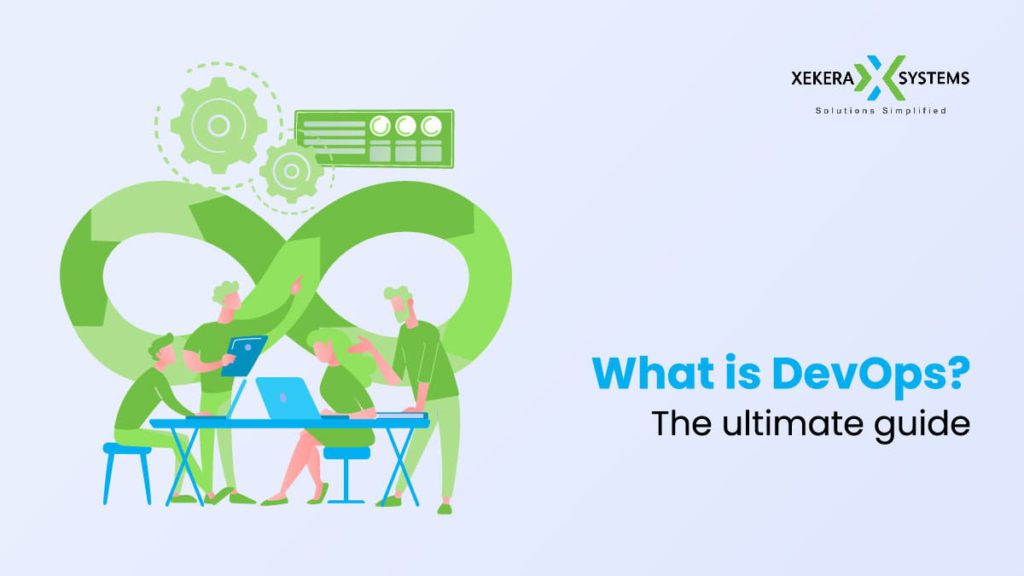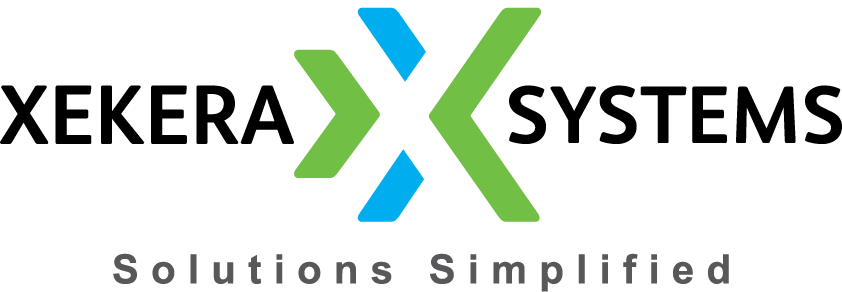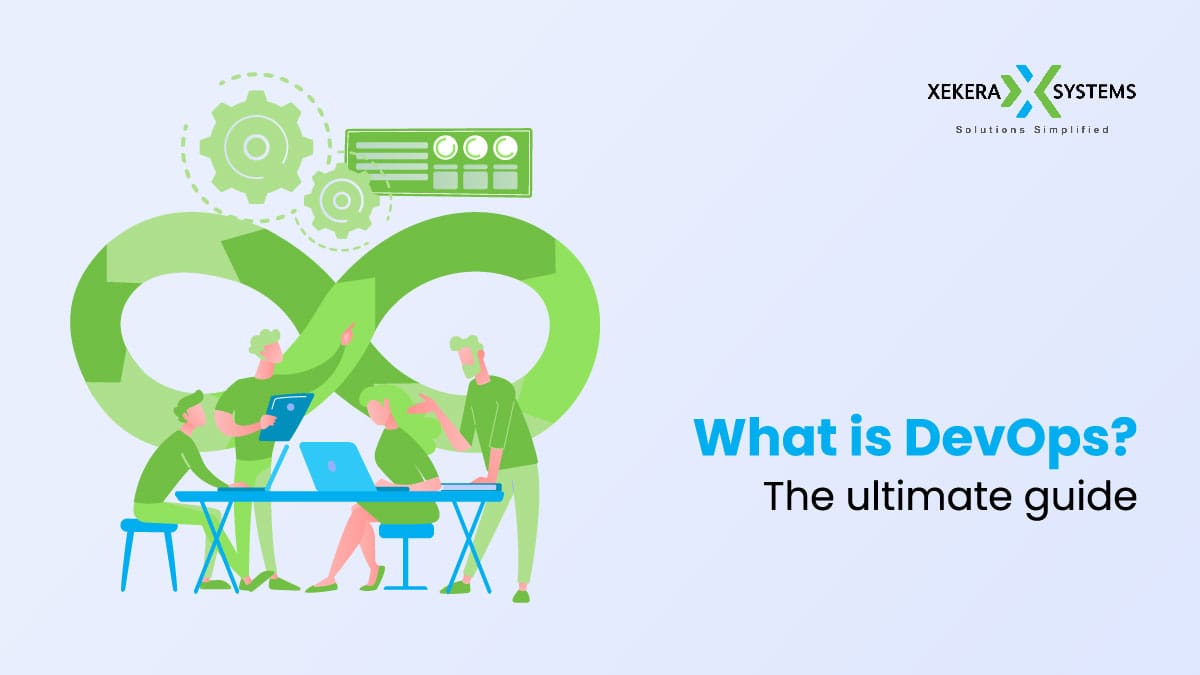Software development and IT operations are combined through a set of principles called “DevOps.” It seeks to provide continuous delivery with high software quality and shorten the systems development life cycle. Agile software development and DevOps go hand in hand; in fact, a number of DevOps components originated from Agile.
DevOps is a mindset that, in its broadest sense, encourages improved communication and collaboration between these teams and other groups within a company. DevOps refers to the use of iterative software development, automation, and programmable infrastructure deployment and maintenance in its most limited sense. The phrase also refers to cultural shifts like fostering cohesiveness and trust between developers and systems administrators and coordinating technical initiatives with organisational needs. The software delivery process, services, employment responsibilities, IT tools, and best practises can all be altered by DevOps.
Although DevOps is not a technology, environments that use it frequently use standard approaches. They consist of the following:
- Tools for continuous integration and delivery, also known as continuous deployment (CI/CD), with a focus on task automation;
- Platforms for collaboration, real-time monitoring, issue management, configuration management, and other DevOps adoption-supporting technologies and tools; and
- Microservices, containers, and cloud computing are being employed simultaneously with DevOps practices.
One of the various methods employed by IT workers to carry out IT projects that satisfy business goals is the DevOps methodology. Agile software development, IT service management frameworks like ITIL, project management guidelines like Lean and Six Sigma, and other tactics can coexist alongside DevOps.
Some IT professionals feel that the word DevOps should explicitly encompass business (BizDevOps), security (DevSecOps), or other areas, and that the basic coupling of Dev and Ops is insufficient.

How does DevOps work?
A methodology called DevOps aims to enhance productivity throughout the whole software development lifecycle. Plan, code, build, test, release, deploy, operate, monitor, and — through feedback — plan, which resets the cycle, are the processes that make up a DevOps process.
DevOps implies that an IT team creates software that fully satisfies user requirements, instals quickly, and performs well right away. To do this, organisations use a mix of culture and technology.
Developers and stakeholders discuss the project and collaborate on incremental upgrades that go live independently of one another in order to align software to expectations.
IT teams move code automatically from one stage of development and deployment to another using CI/CD pipelines and other automation techniques to reduce wait times. Teams can implement regulations to make sure that releases adhere to standards and instantly review changes.
Software can be written quickly and easily, but making it operate is a another matter. DevOps proponents employ containers or other techniques to ensure the programme behave consistently from development through testing and into production in order to release good code. They implement modifications one at a time so that issues may be tracked. For consistent hosting and deployment environments, teams rely on configuration management. Code modifications are frequently made in response to issues they find during live operations, frequently following a transparent post-mortem analysis and regular feedback loops.
Developers may provide support for the running software, therefore it is their responsibility to address runtime issues. In the software design meetings, IT operations managers could be present and provide advice on how to use resources effectively and safely. To blameless post-mortems, anyone may contribute. These experts can promote a DevOps culture more effectively if they cooperate and share their abilities more.
What problems does DevOps solve?
Although every business has its own difficulties, common issues include releases that take too long, subpar software, and IT that restricts business expansion.
A DevOps project progresses more quickly from the specification to live software since there are no wait times, manual processes, or drawn-out reviews. Reduced cycle times can prevent requirements from changing, ensuring that the final product meets client expectations.
Between IT specialities, DevOps resolves issues with prioritisation and communication. Development teams must comprehend the production environment and test their code under realistic circumstances in order to provide workable software. The silos that a conventional organisation creates for development and operations teams. This means that developers are happy when their code provides functionality; if the release has issues in production, the operations team is responsible for fixing them.
With a DevOps culture, engineers don’t revert to the “It worked on my machine” approach when an issue develops. The modifications introduced into production are minor and reversible. Additionally, the modifications are understood by everyone in the team, which makes incident management much simpler.
Companies are better able to take advantage of market opportunities with a quicker path from idea to live software. DevOps gives organisations a competitive edge in this approach.
The advancement of DevOps
By branding a conference DevOps Days in 2009, software development expert Patrick Debois is credited for coining the phrase DevOps. A flaw in the Agile software development methodology—iterative, quick code development did not always result in iterative, quick code deployment—was solved by DevOps.
IT administrators resented the sometimes tedious and excessively complicated change management stages in the ITIL framework as Agile was pushed deeper into operations. Agile promotes collaboration and change, whereas ITIL champions stable, trustworthy, and predictable IT. People on both sides were moved by DevOps. Organizations may actually use both ITIL and DevOps, especially if they embrace the cloud.
The Phoenix Project, a book published in 2013, helped to further popularise the term “devops.” The Phoenix Project employs a fictitious story to highlight persistent issues and aid IT administrators in comprehending the ideas and advantages of teamwork and shared technologies.
These significant figures were among the early DevOps supporters:
- Debois, together with his associate Andrew Clay Shafer;
- writers of The Phoenix Project, George Spafford, Kevin Behr;
- John Allspaw and Paul Hammond, two significant early adopters at Flickr;
- Jez Humble and Dave Farley, pioneers of continuous delivery;
- John Willis, a supporter of containerization; and
- Organisers of the State of DevOps Report, Nicole Forsgren and Alanna Brown.
As DevOps gained popularity, businesses formalised DevOps methods. DevOps Dojo training was developed by retailer Target, for instance. In addition to communication chatbots and CI/CD suites integrated into cloud services, vendors highlighted the technologies’ ability to support DevOps. The title “DevOps engineer” quickly became popular.
DevOps is still developing as artificial intelligence is used to help with everything from incident management to code creation. There are still many obstacles to overcome before AI for DevOps (or AIOps) becomes a reality, including smarter automation, even reduced wait times, and smoother translations from business demand to technology offering.
Even while DevOps has become widely accepted, not all early adopters have fully embraced it. Many people use a DevOps strategy for IT projects that generate income because they get a return on their investment in cutting-edge equipment and expertise. DevOps does not provide many internal IT services with substantial advantages that are stable and mature.
Theories, Guiding Ideas, and Tactics
DevOps is linked to Agile software development because DevOps was touted as a way to carry the approach into production by Agile practitioners. Even worse, the method has been dubbed a counterculture to the IT service management methods promoted by ITIL. There is no recognised structure for DevOps.
Organizations should comprehend the connected contexts of DevOps, Agile and Waterfall development, site reliability engineering (SRE) and SysOps, as well as the variations within DevOps, in order to refine their tactics.
Waterfall development Vs DevOps. A waterfall development process consists of a number of steps and gates leading up to production. Requirements, analysis, design, coding, implementation, testing, operation, deployment, and maintenance are its phases. In Waterfall teams, development QA-tests new code in an isolated setting before releasing it to operations for use in production if specifications are satisfied. Multiple releases are deployed simultaneously by IT operations under strict restrictions. Operation’s responsibility is support. Long periods of time pass between software releases under waterfall methodologies. As a result of the separation of the development and operations teams, operational challenges that prohibit code from functioning as expected are sometimes not known to developers.
The DevOps model aligns development, QA, and IT operations efforts for fewer gates and more continuous workflows. For example, some operations team responsibilities are shifted to development teams in the app delivery pipeline. IT Operations provides feedback on code improvements. DevOps relies on continuous development, continuous integration, continuous delivery, and continuous monitoring processes instead of gated procedures.
DevOps vs. Agile development. Agile is a software development approach defined by the Agile Manifesto. Agile teams focus on incremental, rapid cycles of writing and deploying code called sprints. Each sprint is repeated at the end, so the software is very flexible and can adapt to changing requirements. This cycle can erode the original vision of the project.
DevOps says Agile’s success in increasing development velocity and the disconnect between development and operations teams and between the IT and business sides of an organization severely impede the delivery of agile software to users. Born of awareness.
In a pure Agile workflow, development and operations teams have separate goals and leadership. When an organization uses DevOps and Agile together, both development and operations teams manage code throughout the software development lifecycle. Agile work is often formalized in frameworks like Scrum, but DevOps has no framework.
DevOps vs. SRE. Site Reliability Engineering came along with Agile and DevOps. Started at Google in the early 2000s, it is essentially a coding and automation focused approach to the software development lifecycle. The problem should be resolved in a way that prevents it from reoccurring. Red tasks should be kept to a minimum.
The SRE toolbox is very similar to the DevOps toolbox. Both areas aim for continuous improvement. SRE and DevOps engineers are trying to break down the silos between development and operations. DevOps can extend to business stakeholders, but SRE typically stays within IT processes.
DevOps versus SysOps. SysOps usually means that IT administrators or IT teams are responsible for the operational deployment and support of large-scale distributed applications. B. His SaaS product under management. Like DevOps adopters, SysOps teams must be familiar with cloud computing and automation, and other technologies that enable applications to perform well at scale. SysOps teams troubleshoot IT outages and incidents, monitor performance issues, enforce security policies, and optimize operations.
You, like any IT administrator, are focused on high availability, fault tolerance, security, and performance. SysOps professionals may use some development tools and understand the development process, but their work is not as tightly integrated with development as that of DevOps. However, SysOps roles can exist within DevOps and SRE organizations.
DevSecOps vs BizDevOps vs GitOps. Some organizations are expanding the scope of DevOps to include other roles and departments. In DevSecOps, security planning, scanning, testing, and reviewing occur continuously throughout the DevOps loop. BizDevOps is focused on connecting executives, application owners, and other business stakeholders with the technical teams that develop, test, and support software. More collaboration is definitely better than less, but these employees need to share input in an effective, timely, and accurate way.
Another variant of DevOps, or another faction of the same movement, is GitOps. Named for its focus on repository and eponymous version control technology, GitOps champions declarative source control of application and infrastructure code. Get everything about your software from a single source of truth, from functional requirements to deployment environments.
DevOps Benefits and Challenges
DevOps benefits include:
- Reduce your software time to market by:
- Rapid improvements based on feedback.
- Downtime decreased
Improving the entire software delivery pipeline with Build, Validate, and Deliver. - Less menial tasks thanks to automation.
- Optimized development process with increased responsibility and code ownership in development.
- Wide range of roles and abilities.
However, DevOps presents many challenges.
- organizational and IT department changes. Including new skills and jobs.
- expensive tools and platforms. Including training and support to use them effectively.
- Development and dissemination of IT tools.
- Unnecessary, vulnerable, or insecure automation.
- Scaling DevOps across multiple projects and teams.
- High-risk assignments with a fail-fast mentality and job generalization and specialization.
- Regulatory compliance, especially where separation of roles is required. and
- new bottlenecks.
DevOps Adoption
DevOps transformation doesn’t happen overnight. Many companies start with a pilot, a simple application to get a feel for new practices and tools. Try a phased approach to large-scale DevOps adoption.
First, DevOps means that development and IT operations teams understand the concerns and technical limitations that exist at each stage of a software project. Agree on KPIs for improvement. B. Shorter cycle times or fewer errors in manufacturing. Communicating across roles lays the foundation for an ongoing process.
Evaluate tools available for development and IT operations. Identify defects. B. Steps that are always performed manually or tools without an API to connect to other tools. Consider standardizing your DevOps pipeline across your enterprise. Pipelines allow team members to move from one project to another without retraining. Security specialists can tighten their pipeline and simplify license management. The downside of this approach is that it gives up the freedom for DevOps teams to use what works best for them.
The company now has a DevOps mindset, success metrics, and powerful tools. Focus on best practices, knowledge sharing, and skill development to keep improving. Optimize tools and technology to identify roadblocks and gaps that impact KPIs.
Organizations can use the DevOps maturity model as a guide for adoption.
Initial. Teams are isolated. The work is reactive and done with ad-hoc tool and process choices.
Definition. A pilot project defines a DevOps approach, basic processes, and tools. This is a proof of concept.
Administration. The organization uses lessons learned from the pilot to expand its DevOps adoption. Pilot project results are reproducible across different employees and project types.
Measurements. When processes and tools are in place, teams share knowledge and improve their practices. Automation and tools are becoming more connected, and standards are being enforced through policy.
Optimization. There are continuous improvements. DevOps can evolve into different toolsets or processes to address use cases. For example, customer-centric apps release more frequently, and financial management apps follow his DevSecOps practices.
DevOps Tools
DevOps is a mindset, not a toolset. But without the right tools, it’s hard for IT teams to get anything done. DevOps practitioners typically rely on CI/CD pipelines, containers, and cloud hosting. Tools are open source, proprietary, or distributions of supported open source technologies.
Code repository. A versioned source code repository allows multiple developers to work on the code. Developers can check out code and revert to previous versions of code if necessary. These tools record changes to your source code. Without tracking, developers can struggle to keep track of which changes are new and which versions of code are available to end-users.
In a CI/CD pipeline, committing a code change in a version control repository automatically triggers the next step. B. Static code analysis or build and unit tests. Source control tools include Git and GitHub.
Artifact repository. Source code is compiled into artifacts for testing. Artifact repositories enable versioned, object-based output. Managing artifacts is a best practice for the same reasons as managing versioned source code. Examples of artifact repositories are JFrog Artifactory and Nexus repositories.
CI/CD pipeline engine. CI/CD enables DevOps teams to frequently validate and deploy applications to end users through automation during the development lifecycle. Continuous integration tools initialize the process so developers can build, test, and validate code in a common repository as needed without manual effort. Continuous Delivery extends these automated steps with configuration settings for production-level testing and release management. Continuous deployment takes this one step further and calls for testing, configuration, deployment, and monitoring and potential rollback capabilities. Common tools for CI, CD, or both are Jenkins, GitLab, and CircleCI.
Container. A container is an isolated runtime for software on a shared operating system. Containers provide an abstraction that allows your code to work the same across different underlying infrastructures, from development to testing, staging to production. Docker is the most popular containerization software and Microsoft offers specific Windows container options. Container orchestrators such as Kubernetes and commercial Kubernetes distributions Red Hat OpenShift and Amazon Elastic Kubernetes Service automatically deploy, scale, and maintain containers.
Configuration Management. Configuration management systems allow IT to deploy and configure software, middleware, and infrastructure based on scripts or templates. DevOps teams can use configuration management tools to set up delivery environments for software code releases and apply policies to servers, containers, and VMs. Changes to deployments can be versioned and tested, allowing DevOps teams to manage their infrastructure as code. Configuration management tools include Puppet and Chef.
Cloud environment. DevOps organizations often adopt cloud infrastructures simultaneously because they can automate provisioning, scaling, and other administrative tasks. AWS and Microsoft Azure are among the most widely used cloud providers. Many cloud providers also offer his CI/CD services.
Monitoring. Additionally, monitoring tools allow DevOps professionals to observe code release performance and security across systems, networks, and infrastructure. Monitoring can be combined with analytical tools that provide operational information. DevOps teams use these tools together to analyze the impact of code changes on the entire environment. The choices are extensive and include New Relic One, Dynatrace, Prometheus, Datadog and Splunk.
A cloud-based DevOps pipeline. Public cloud providers offer native DevOps toolsets for use with workloads on their platforms. A partial list includes AWS CodePipeline and CloudFormation, Azure DevOps and Pipelines, and Google Cloud Deployment Manager. Cloud adopters can choose to use these pre-integrated services or run third-party tools. For example, organizations can use HashiCorp Terraform or CloudFormation to create infrastructure-as-code templates for AWS workloads.
As-a-Service model. Finally, DevOps as a Service is a delivery model for a set of tools that facilitate collaboration between an organization’s software development and IT operations teams. In this deployment model, the vendor brings together a set of tools to handle the integration, seamlessly covering the entire code creation, deployment, and maintenance process.
DevOps Skills
DevOps is often referred to as a philosophy or a collaborative IT culture, rather than a rigidly defined job description or skill set. Due to the sheer breadth of the field, DevOps positions are better suited to IT generalists than specialists.
The DevOps Engineer role does not fall into his career path. Professionals can fill positions from a variety of backgrounds. For example, software developers can acquire skills on the job. B. Configuring a hosting infrastructure to become a DevOps Engineer. Similarly, a system administrator with programming, scripting, and testing skills can become a DevOps engineer.
Many DevOps jobs require knowledge of containers, cloud, CI/CD, and soft skills. DevOps engineers may also need to change processes and solve organizational problems in order to achieve business outcomes.
Other titles commonly found in DevOps organizations include:
- Infrastructure developer;
- Site reliability engineer;
- Build and release engineer;
- Full-stack developer;
- Automation specialist; and
- CI/CD platform engineer.
Most entry-level DevOps jobs require a degree in computer science or a related field covering coding, QA testing, and IT infrastructure components. Advanced degrees in system architecture and software design may be required for higher positions. Those on this career path should also expand their knowledge through DevOps books and network with other members of the community through blogs and conferences.
There is no industry-recognized DevOps certification for him like a formal framework like ITIL. IBM Red Hat offers DevOps certifications, and the DevOps Institute offers vendor-neutral options from basic to expert levels.



